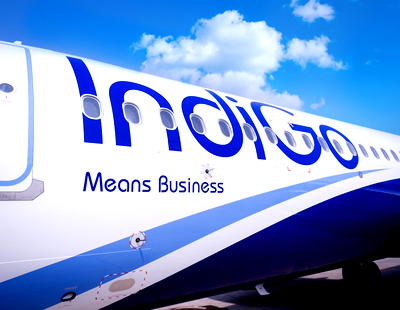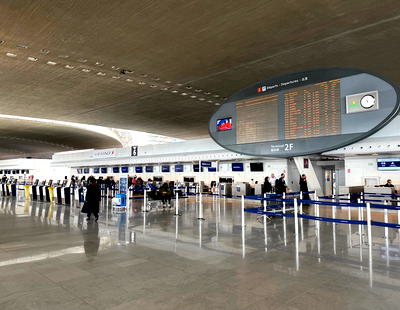The Paris Air Show is kicking off today, which is an event where airlines often announce aircraft orders. The event is off to quite a start, as IndiGo and Airbus announced a record-breaking aircraft order.
In this post:
IndiGo places Airbus A320neo order
Indian low cost carrier IndiGo has just announced a firm order for 500 Airbus A320neo family aircraft. This represents the largest single aircraft order with one aircraft manufacturer in history.
This is part of IndiGo’s long term growth strategy, as these planes will join the carrier’s fleet between 2030 and 2035. The order includes both the A320neo and A321neo, though we don’t know the breakdown between those jets yet. Taking delivery of around 100 aircraft per year for five years represents quite a fast delivery timeline, and shows just how much growth the airline has planned.
For context, IndiGo is currently India’s largest airline in terms of number of planes and passengers carried, and the airline has over 50% domestic market share in India. The company’s CEO is Pieter Elbers, the former CEO of KLM.
IndiGo’s fleet currently consists of just over 300 planes, nearly 250 of which are Airbus A320neo family aircraft. On top of that, the airline already has nearly 500 Airbus A320neo family aircraft on order, including the A320neo, A321neo, and A321XLR.
When you add this all up, IndiGo has nearly 1,000 Airbus A320neo family aircraft on order, which is unheard of. When you combine it with IndiGo’s current fleet, that adds up to around 1,300 Airbus A320 family aircraft. Admittedly some of these existing planes will probably be retired before all planes are delivered.
Here’s how IndiGo’s CEO describes this aircraft order:
“It is difficult to overstate the significance of IndiGo’s new historic order for 500 Airbus A320 Family aircraft. An order book now of almost 1000 aircraft well into the next decade, enables IndiGo to fulfil its mission to continue to boost economic growth, social cohesion and mobility in India. At IndiGo, we take pride in being India’s preferred airline for connectivity in and with India; and by doing so, being one of the leading airlines in the world. This order strongly reaffirms IndiGo’s belief in the growth of India, in the A320 Family and in our strategic partnership with Airbus.”

It’s an amazing time for Indian aviation
It’s so cool to see how Indian aviation is transforming for the better. For one, while IndiGo commenced operations in 2006, the airline has ramped up growth efforts in recent years. The airline took delivery of its first A320neo in 2016, and over the course of under 20 years, the airline will take delivery of around 1,300 of those planes.
That’s an average of around 65 planes per year, or well over one plane per week. Seeing that level of growth over such a long period is nothing short of remarkable.
IndiGo also isn’t the only airline that’s growing in India. Star Alliance airline Air India is undergoing a transformation, after having been privatized. The airline ordered nearly 500 Airbus and Boeing jets, and is trying to reinvent itself in terms of its fleet, passenger experience, and more.
I don’t think there’s a big country in the world where aviation will be transformed as much over the course of a couple of decades as what we’re seeing in India right now. I can’t wait to continue to see how this unfolds.

Bottom line
IndiGo has placed an order for 500 Airbus A320neo family aircraft, to be delivered between 2030 and 2035. This complements the roughly 800 Airbus A320neo family aircraft that the airline either already has in its fleet, or has ordered prior to this announcement. This is a record breaking order, and reflects just how much growth the aviation sector is seeing in India.
What do you make of IndiGo’s latest Airbus A320neo order?





The real question is why aren’t Southwest and Ryanair investing into new aircraft?
Idotic beyond belief to fly so many narrowbodies in an overpopulated country like India. Will only lead to delays and congestion.
The "Amazing Time For Indian Inflation" has been a constant song since the duopoly Air India - Indian Airlines ended and since new entrants were allowed.
Several major players have collapsed, mostly as a direct consequence of India's red tape and poor organizational skills. The re-purchase of Air India by Tata (who created Air India) is a very positive sign, but there is a substantial risk that the "Major Aircraft Order in History" may become...
The "Amazing Time For Indian Inflation" has been a constant song since the duopoly Air India - Indian Airlines ended and since new entrants were allowed.
Several major players have collapsed, mostly as a direct consequence of India's red tape and poor organizational skills. The re-purchase of Air India by Tata (who created Air India) is a very positive sign, but there is a substantial risk that the "Major Aircraft Order in History" may become the "Major Aircraft Cancellation in History".
Big aircraft orders are always announced during the Le Bourget and Farnborough air shows. It's a tradition. Then one loses focus and these orders often do not materialize.
Why are Indian carriers not ordering widebodies for their domestic market ?
Those narrow bodies will need to get landing slots, pilots and crew. And India is a low yield market.
I wonder why we don't see more high density A330neos to operate the trunk triangle (Dehli-Mumbai-Bangalore) which represents several million passengers.
Ok. Lots of ill informed comments here.
First, there are over 21 additional airports in process of construction in India, to add to the existing slots.
Second, the aircraft will be delivered over a number of years, allowing the airline to retire its ageing fleet with newer aircraft. The definition of ageing is very different for a ULCC which tries to minimise the cost of maintenance ads generally retires aircraft beyond an age of five years.
Lucky: "I can’t wait to continue to see how this unfolds."
Me: "Can't wait to see your review(s) of IndiGo" :)
He's an elitist, so no way hah. He's never stepping foot on one of these carriers, especially without a premium cabin. I do not even recall him taking a Premium Economy flight.
With that said, I once flew on Indigo from Dehradun to Delhi. A 20 min flight in the most uncomfortable seat, but it was either that or a 7 hour road trip back to Delhi, which I refused. We paid the drivers to...
He's an elitist, so no way hah. He's never stepping foot on one of these carriers, especially without a premium cabin. I do not even recall him taking a Premium Economy flight.
With that said, I once flew on Indigo from Dehradun to Delhi. A 20 min flight in the most uncomfortable seat, but it was either that or a 7 hour road trip back to Delhi, which I refused. We paid the drivers to drive the SUV's back empty....no way was I subjecting myself to those roads again.
Sometimes you have to fly Y, and it's not all bad. Just get a seat up front and call it a day.
Ben time for you to plan a review trip to india
Curious to see how the Indian airports will have the capacity to handle so many new aircraft being acquired by these airlines and how many new routes can be accommodated
India is on major infrastructure development and upgrade spree. As part of it many new airports are built across the nation and additional 72 new airports are expected by 2025 itself.
Major Indian airports are either artificially constrained (eg. Goa, Pune) due to military bases being co-located, or are in metro areas where second airports (eg. Navi Mumbai, Jewar) are being constructed. The infrastructure is changing for the better and air connectivity is getting broader, while at the same time improved rail infrastructure will relieve some of the pressure from shorter routes.
Great to hear India is expanding airport.
Good for the economy as it probably create thousands more jobs for someone to check your boarding pass for the 17th time before you actually reach your plane.
Don’t forget that IndiGo is in separate talks for a widebody order. This is not the end of the story!
Indigo has historically kept aircraft only for 6-8 years and then phased them out to be replaced by newer deliveries. So even though this order is for 500 airframes and their pending order book is around 1000 airframes, the reality is that these deliveries will be over a period of time and around half of the aircraft will be used to replace existing airframes. Indeed, some of the earlier aircraft in the order will probably...
Indigo has historically kept aircraft only for 6-8 years and then phased them out to be replaced by newer deliveries. So even though this order is for 500 airframes and their pending order book is around 1000 airframes, the reality is that these deliveries will be over a period of time and around half of the aircraft will be used to replace existing airframes. Indeed, some of the earlier aircraft in the order will probably be replaced by the latter deliveries in the same order!
How does that makes financial sense? I don't doubt that it does, I'm just interested in learning how. While I get that keeping aircraft new means lower maintenance, higher operational reliability, (usually) more fuel efficient, etc. 6-8 years seems excessively short. I mean, planes don't go obsolete that fast.. And typical major maintenance checks aren't for 10-12 years, I believe, so it's not like a 6 year old jet is breaking down all the time...
How does that makes financial sense? I don't doubt that it does, I'm just interested in learning how. While I get that keeping aircraft new means lower maintenance, higher operational reliability, (usually) more fuel efficient, etc. 6-8 years seems excessively short. I mean, planes don't go obsolete that fast.. And typical major maintenance checks aren't for 10-12 years, I believe, so it's not like a 6 year old jet is breaking down all the time or needs a lot of maintenance expense...
The only way I can see it working out is that if you get an exceptionally good deal on the initial purchase price, and you're banking on good resale value to essentially make the plane free for the time you used it. I remember hearing that Ryanair drove such a good bargain on their original 737 purchases that they actually made money when they sold them used! If you're getting close to those types of economics, then maybe cycling through aircraft rapidly can make sense?
@Lune - Indigo engages in sale-leaseback transactions extensively, so they get deep discounts on high volume purchases and then immediately free up cash by selling these aircraft to leasing companies when they are delivered. If managed well (such as your Ryanair example above), it basically reduces the ownership cost component of the CASK to something negligible relative to the other operating costs.